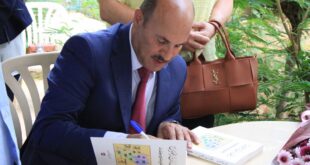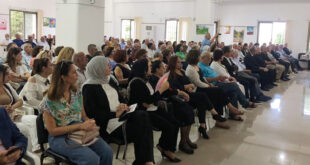كامل جابر
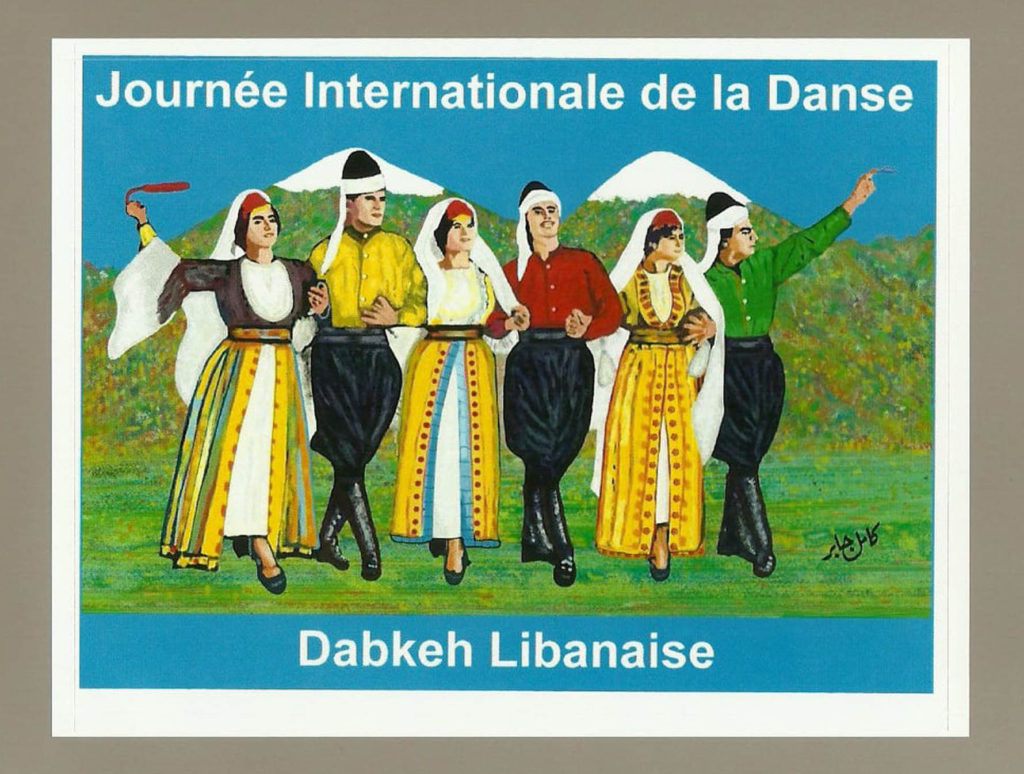
احتفالاً باليوم العالمي للرقص 29 نيسان 2021، اختارت جمعيّة “ليبا” الدّبكة اللبنانيّة كموضوع الطابع الخاص الفرنسي. صورة الطابع من تصميم كامل جابر الذي كان قد إختار الصورة لمناسبة يوم المرأة العالمي في 8 آذار 2021.
تمّ تأسيس “اليوم العالمي للرقص” من قبل “اللّجنة الدوليّة للرّقص التابعة للمعهد الدّوليّ للمسرح”، الشريك الرئيسي لليونسكو لفنون الأداء. ومنذ إنشائها في العام 1982، تختار اللّجنة الدوليّة للرّقص والمعهد الدولي للمسرح كلّ عام شخصيّة راقصة لكتابة رسالة بمناسبة اليوم العالمي للرقص.
الطابع صدر في فرنسا بكمّية محدودة يمكن للراغبين في الحصول عليه مراسلة رئيس جمعية ليبا البرفسور إيلي عواد عبر الفايسبوك أو المسنجر Elie Aouad . وترافق صدور الطابع مع مغلف اليوم الأول للإصدار ومطويّة تعريف بالطابع والدبكة واليوم العالمي للرقص.
وفي “البروشور” المرفق مع الطابع أن “الدبكة (بالعربية “ركلة”). هو نوع من الرقص الشعبي المعروف في بلاد الشام، ولها العديد من الأنواع المحلّية. إنّها رقصة جماعية حيث يمسك الراقصون بأيديهم ويضربون الأرض بقوّة. غالبًا ما تُرقص الدبكة في حفلات الزفاف والمآدب والحفلات العرضية. رأس الدبكة يدير الرقص والراقصين الآخرين معه ويُسمح له بارتجال رقصته. يلوح الرأس بيده اليمنى مسبحة أو منديل مجعد. أحياناً يصرخ الراقصون للتحميس أو ضبط الإيقاع.
أنواع الدبكة اللبنانيّة: الهوّارة، الشماليّة، البعلبكيّة، المتنيّة، الغزيّل، المتلّتة، الدلعونة…
ما كان الفلكلور اللبناني بتاريخه الموثّق، فلكلوراً ذكورياً يقتصر على حلقات رجالية، إنما شكلت المرأة فيه نسبة المناصفة والتميز إن لم نقل أكثر. والدبكة اللبنانية التي هي أساس هذا الفلكلور، كانت منتشرة في المناطق اللبنانية كافة، وكانت سيدة الساحات والبيادر، وكانت همزة وصل في لقاء العاشقين، يداً بيد وكتفاً إلى جانب كتف، وفي الهيصة ومطارحات الدلعونة. وجاء الطرب الشعبي اللبناني، إلى جانب المسرح في أعمال كثيرين من الرواد، منهم الرحابنة وروميو لحود وزكي ناصيف ووليد غلمية وفرقة كركلا وغيرها من الفرق التي انطلقت في فترات متلاحقة، لتكرس فنّاً نعم بشهرة عالمية وعربية، لعبت المرأة فيه دوراً ريادياً، إذ كانت سيدة الأعمال الفنية والمسرحية والغنائية، من دون منازع في أحيان كثيرة، ونذكر هنا فيروز وصباح وسلوى القطريب وغيرهن، وبقيت حلقات الدبكة والرقص الشعبي لا تكتمل من دون المرأة، بلباسها المشتق من تراث اللباس اللبناني، المتطور في أعمال التصميم والإضافة، ليشكل لاحقاً عموداً من أعمدة الفلكلور الشعبي.
***
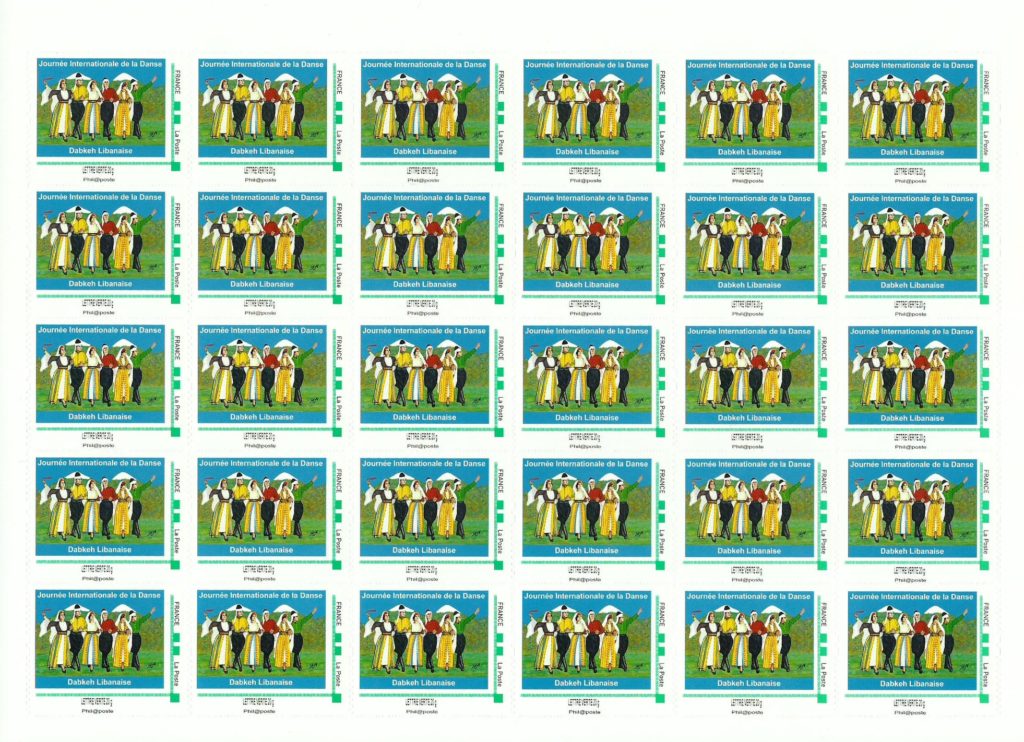
International Dance Day:
To celebrate this day the Léba Association chose the Lebanese Dabkeh as the topic of issue of the French custom stamp. Visual is a creation of Mr. Kamel Jaber who once used it to celebrate World Women’s Day.
30 and 10 stamp boards, First day envelopes.
International Dance Day was created by the International Dance Committee of the ITI International Theatre Institute, UNESCO’s leading partner for performing arts. Since its inception in 1982, the International Committee of Dance and the International Institute of Theatre ITI have chosen an outstanding dance personality every year to write a message for International Dance Day.
The dabkeh (Arabic: dbḵẗ, ′′ kick ′′) is a type of folk dance known at Levant, with several regional versions. This is an online group dance where dancers hold hands and hit the floor strongly. She is most often danced in weddings, banquets and occasional parties.
The leader of the dabkeh train dance and other dancers with him. He is called ras and is allowed to improvise his dance. He holds a masbaha rosary or a curly tissue on his right hand and makes him rotate in the air. Dancers sometimes scream to keep the beat up. In Lebanon several styles exist like: Houwwara, Chemaliyyeh, Baalbakiyeh, Mitniyeh, Gzayyel, Mtallaté, Dalouna….
Lebanese folklore with its documented history, is not a male folklore confined to male circles, rather women formed the share of parity and distinction. The Lebanese Dabkeh, which is the basis of this folklore, was prevalent in all Lebanese regions. She was the lady of the seats and the bayaders, and a bond in meeting the two lovers, hand in hand and shoulder next door, in the haysa and dalouna.
In addition to the theater, Lebanese folk song has known many pioneers, such as the Rahabnis, Romeo Lahoud, Zaki Nassif, Walid Gholamiyeh, Caracalla Ensemble, and other bands, to dedicate Arab and international fame art, in which the women played pioneering roles like Feyrouz, Sabah, Salwa Al-Qatrib and others. Dabkeh and folk dance circles remain incomplete without women wearing their clothes from Lebanese tradition.
International Dance Day: Liba Dabke has chosen Lebanese association as the subject of French special character. A picture of the stamp designed by Mr. Kamel Jaber who had chosen the picture for International Women’s Day.
International Dance Day was established by the International Committee of Dance of the International Institute of Theatre, UNESCO’s main partner for performing arts. Since its inception in 1982, the International Dance Committee and the International Institute of Theatre each year have selected a dancer character to write a letter on the occasion of World Dance Day. In celebration of this day,
Dabke (Arabic ′′ Kick ′′) is a type of popular dance known in the Levant, and has many local genres. It’s a group dance where dancers hold their hands and hit the ground hard. Dabke often dances at weddings, banquets and occasional parties. Dabke Head runs dance and other dancers with him and allows him to improvise his dance. Head waving with his right hand rosary or curly napkin. Sometimes dancers scream for enthusiasm or tuning in. Types of Lebanese Dabke: Hawara, Northern, Baalbekiyeh, Metna, Ghazil, Oriental, Dalouna…
Lebanese folklore was not in its documented history, male chlorine is limited to men’s rings, but women formed the percentage of equity and excellence if we did not say more. The Lebanese Dabke, which is the basis of this folklor, was spread throughout all Lebanese regions, and was the lady of Squares and Al-Bayader, and was a hamza arranged in the encounter of lovers, hand in shoulder and shoulder, and in Husa and the spoilers.
The Lebanese popular rapture, alongside the stage, came in the works of many pioneers, including Rehabna, Romeo Lahoud, Zaki Nassif, Walid Ghalmia, Karkla and other teams that were launched in subsequent periods, to devote a yes art with international and Arab fame. The woman played a leading role in it, since she was often the artistic, theatrical and lyricist business woman, and we mention Fayrouz, Sabah, Salwa Al-Qatarib and others, and the dabke and folk dance episodes are not complete without women, but dress Its derived from the heritage of Lebanese dress, developed in the design and addition works, later form a column of folk folklor.
***
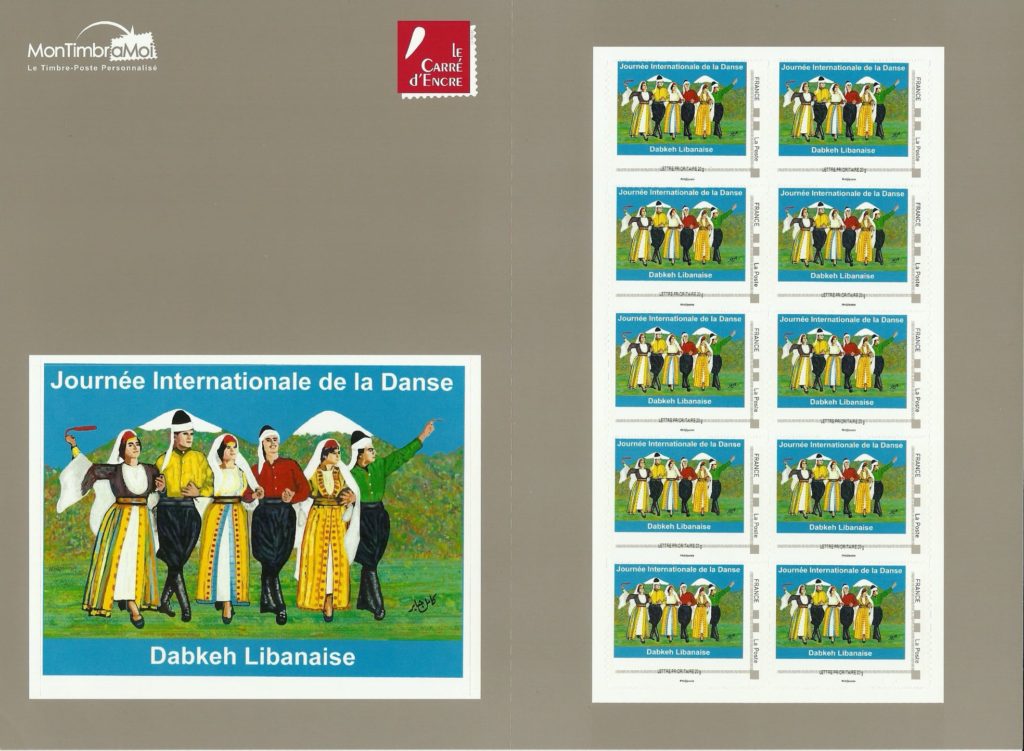
La Journée Internationale de la Danse a été créée par le Comité International de la Danse de l’Institut International du Théâtre ITI, le principal partenaire de l’UNESCO pour les arts de la scène. Depuis sa création en 1982, le Comité international de la Danse et l’Institut international du théâtre ITI choisissent chaque année une personnalité de la danse exceptionnelle pour écrire un message pour la Journée Internationale de la Danse. Pour célébrer cette journée l’Association Léba a choisi la Dabkeh Libanaise comme sujet d’émission du timbre personnalisé Français. Le visuel est une création de M. Kamel Jaber qui l’a déjà utilisé pour célébrer la Journée Mondiale de la Femme.
La dabkeh (en arabe : دبکة, « coup de pied ») est un type de danse folklorique connu au Levant, avec plusieurs versions régionales. C’est une danse de groupe en ligne où les danseuses et danseurs se tiennent les mains et frappent le sol fortement. Elle est le plus souvent dansée dans les mariages, les banquets et les fêtes occasionnelles. …/… Le meneur de la dabkeh entraîne avec lui la danse et les autres danseurs. Il est appelé ras et est autorisé à improviser sa danse. Il tient à la main droite un chapelet masbaha ou un mouchoir bouclé et le fait tourner en l’air. Les danseurs poussent parfois des cris pour entretenir le rythme. Au Liban plusieurs styles existent comme : Houwwara, Chemaliyyeh, Baalbakiyeh, Mitniyeh, Gzayyel, Mtallaté, Dalouna…. Le folklore libanais avec son histoire documentée, n’est pas un folklore masculin se limitant aux cercles masculins, les femmes y formaient plutôt la part de parité et de distinction. La Dabkeh libanaise, qui est à la base de ce folklore, était répandue dans toutes les régions libanaises. Elle était la dame des places et les bayaders, et un lien dans la rencontre des deux amoureux, main dans la main et épaule à côté, dans la haysa et la dalouna. En plus du théâtre, la chanson folklorique libanaise a connu de nombreux pionniers, comme les Rahabnis, Romeo Lahoud, Zaki Nassif, Walid Gholamiyeh, l’Ensemble Caracalla, et d’autres groupes, pour consacrer un art de renommées arabe et internationale, dans laquelle les femmes ont joué un rôle de pionnier comme Feyrouz, Sabah, Salwa Al-Qatrib et d’autres. Les cercles de Dabkeh et de danse folklorique restent incomplets sans les femmes avec leurs habits issus de la tradition libanaise.
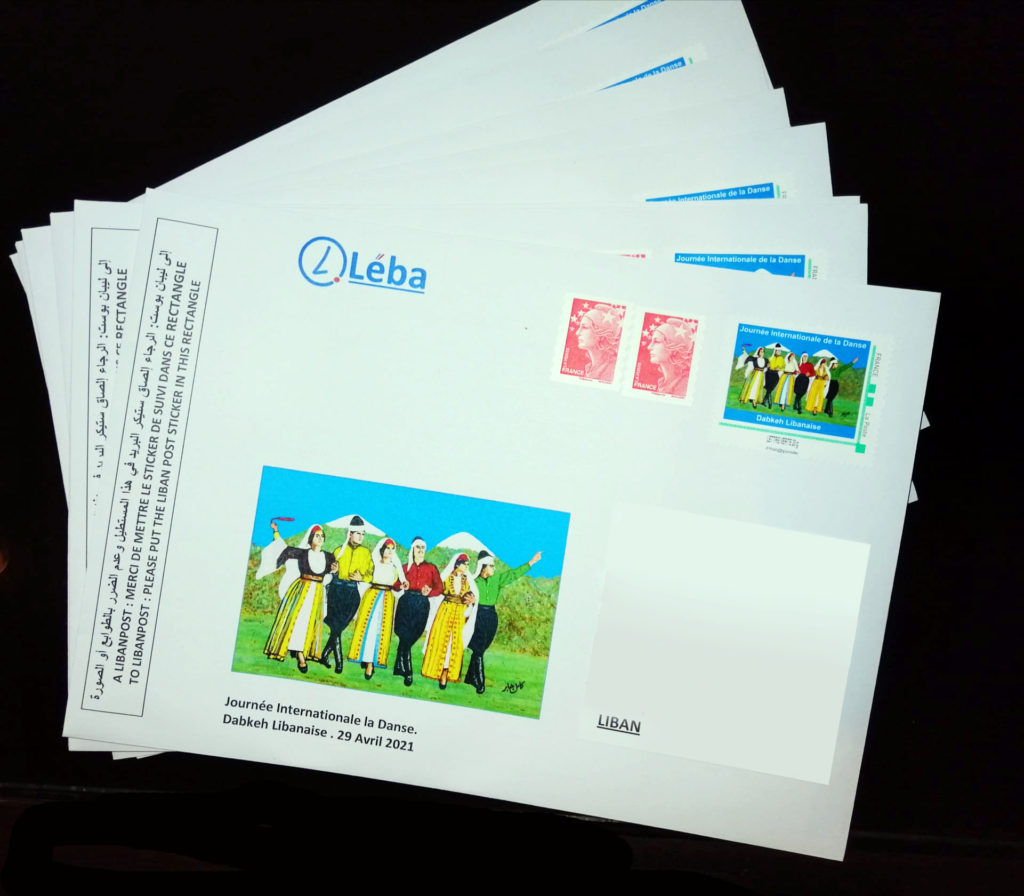
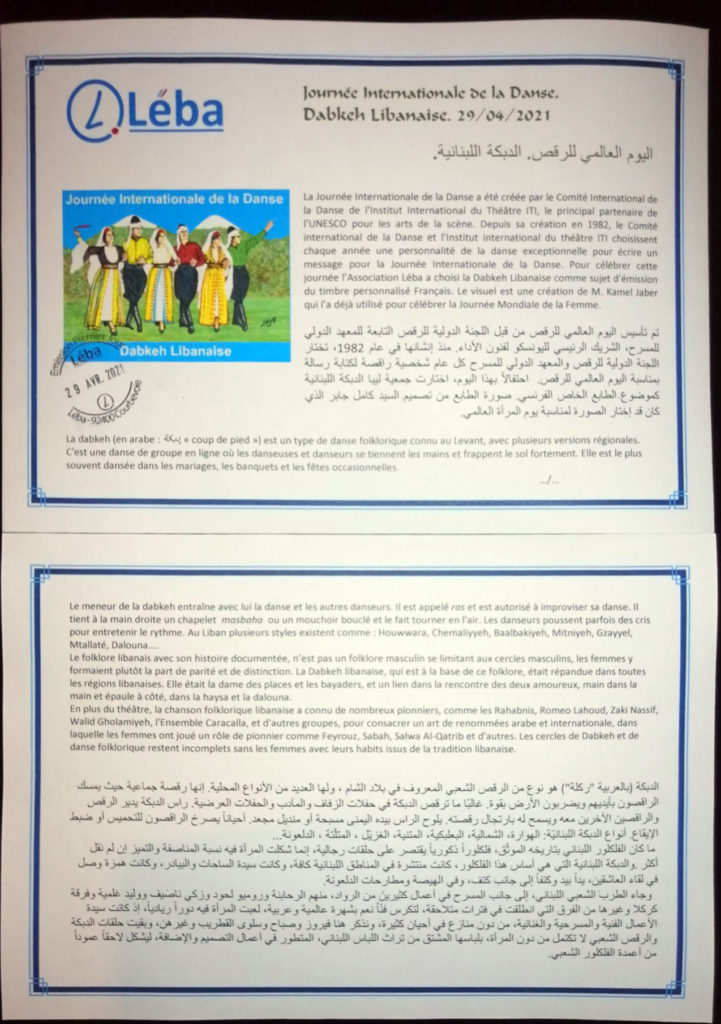
 موقع هوا لبنان
موقع هوا لبنان

